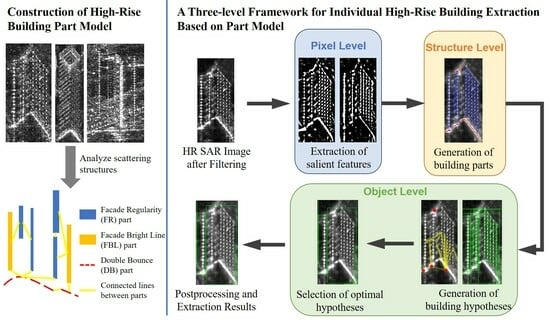Individual High-Rise Building Extraction from Single High-Resolution SAR Image Based on Part Model
Abstract
1. Introduction
2. Scattering Property Analysis and Part Model Construction
2.1. Scattering Properties of High-Rise Building
2.2. Construction of High-Rise Building Part Model
3. High-Rise Building Extraction Method Based on Part Model
3.1. Non-Local Filtering
3.2. Extraction of Salient Features
3.3. Generation of Building Parts
3.3.1. Generation of FR Parts
3.3.2. Generation of DB Parts
3.3.3. Generation of FBL Parts
3.4. Generation of Building Hypotheses
- (a)
- All the parts themselves can be seen as hypotheses.
- (b)
- Introduce edges of facade and DB parts, saved in . As shown in the blue part in Figure 8, the connected subgraphs corresponding to the adjacency matrices under three thresholds are calculated to obtain building hypotheses.
- (c)
- Introduce edges of DB parts, stored in , on the basis of step (b). The rules are shown in the orange part of Figure 8. For example, means that the edges in that are less than and the edges in that are less than together form an adjacency matrix, and the connected subgraph obtained thereby obtains the building hypotheses. It should be noted that the distances between the DB parts are shorter than the edges of facade and DB parts.
- (d)
- Introduce edges between facade parts, recorded in , on the basis of step (b). As shown in the green part in Figure 8, the connection subgraph is generated in a similar way to step (c).
3.5. Selection of Optimal Hypotheses
3.6. Postprocessing
- (a)
- Remove building hypotheses that contain only DB parts, because these may be bright lines formed by roads or low-rise buildings.
- (b)
- Remove building hypotheses that are less than 24 m in range direction and less than 3 m in azimuth direction. This considers the definition of high-rise buildings. However, since the building orientation will affect the azimuth size of them, we set a smaller threshold to avoid missed detections.
- (c)
- Remove hypotheses that are spatially fully subsumed by other building hypotheses. This is usually due to the building facade part being located further away from other parts and not being accepted as a part of the whole building. However, from a spatial perspective, it is very difficult to detect a completely blocked building, so it is removed.
4. Experiments
4.1. Dataset Description
4.2. Results and Evaluations
4.2.1. Preliminary Validity Verification
4.2.2. Qualitative Evaluation
4.2.3. Quantitative Evaluation
4.3. Selection of HRBE-PM Method Parameters
5. Discussion
6. Conclusions
- (a)
- A unified part model, named high-rise building part model, is constructed to describe high-rise buildings in HR SAR images, including a facade regularity (FR) part, facade bright line (FBL) part, double bounce (DB) part, and spatial topology relationships between them.
- (b)
- A three-level framework based on the high-rise building part model, named HRBE-PM, is proposed to extract high-rise buildings, which makes full use of semantic and spatial topological information.
- (c)
- Two evaluation indicators of completeness and compactness are creatively proposed, which can distinguish two adjacent buildings while ensuring the integrity of a single high-rise building.
- (d)
- The HRBE-PM method does not require any auxiliary data and is suitable for extracting different types of high-rise buildings in most single HR SAR images.
Author Contributions
Funding
Data Availability Statement
Conflicts of Interest
References
- Ge, N.; Gonzalez, F.R.; Wang, Y.; Shi, Y.; Zhu, X.X. Spaceborne Staring Spotlight SAR Tomography—A First Demonstration With TerraSAR-X. IEEE J. Sel. Top. Appl. Earth Obs. Remote Sens. 2018, 11, 3743–3756. [Google Scholar] [CrossRef]
- Brunner, D.; Lemoine, G.; Bruzzone, L. Earthquake Damage Assessment of Buildings Using VHR Optical and SAR Imagery. IEEE Trans. Geosci. Remote Sens. 2010, 48, 2403–2420. [Google Scholar] [CrossRef]
- Lu, H.; Zhang, H.; Deng, Y.; Wang, J.; Yu, W. Building 3-D Reconstruction With a Small Data Stack Using SAR Tomography. IEEE J. Sel. Top. Appl. Earth Obs. Remote Sens. 2020, 13, 2461–2474. [Google Scholar] [CrossRef]
- Zhang, X.; Chen, Y.; Jia, M.; Tong, L.; Lu, Y.; Cao, Y. The study of road damage detection based on high-resolution SAR image. In Proceedings of the 2013 IEEE International Geoscience and Remote Sensing Symposium—IGARSS, Melbourne, VIC, Australia, 21–26 July 2013; pp. 2633–2636. [Google Scholar] [CrossRef]
- Li, Y.; Zhang, R.; Wu, Y. Road network extraction in high-resolution SAR images based CNN features. In Proceedings of the 2017 IEEE International Geoscience and Remote Sensing Symposium (IGARSS), Fort Worth, TX, USA, 23–28 July 2017; pp. 1664–1667. [Google Scholar] [CrossRef]
- Ferro, A.; Brunner, D.; Bruzzone, L. Automatic Detection and Reconstruction of Building Radar Footprints From Single VHR SAR Images. IEEE Trans. Geosci. Remote Sens. 2013, 51, 935–952. [Google Scholar] [CrossRef]
- Marin, C.; Bovolo, F.; Bruzzone, L. Building Change Detection in Multitemporal Very High Resolution SAR Images. IEEE Trans. Geosci. Remote Sens. 2015, 53, 2664–2682. [Google Scholar] [CrossRef]
- Aimaiti, Y.; Sanon, C.; Koch, M.; Baise, L.G.; Moaveni, B. War Related Building Damage Assessment in Kyiv, Ukraine, Using Sentinel-1 Radar and Sentinel-2 Optical Images. Remote Sens. 2022, 14, 6239. [Google Scholar] [CrossRef]
- Wu, W.; Guo, H.; Li, X.; Ferro-Famil, L.; Zhang, L. Urban Land Use Information Extraction Using the Ultrahigh-Resolution Chinese Airborne SAR Imagery. IEEE Trans. Geosci. Remote Sens. 2015, 53, 5583–5599. [Google Scholar] [CrossRef]
- Wu, W.; Guo, H.; Li, X. Urban Area Man-Made Target Detection for PolSAR Data Based on a Nonzero-Mean Statistical Model. IEEE Geosci. Remote Sens. Lett. 2014, 11, 1782–1786. [Google Scholar] [CrossRef]
- Wu, W.; Li, X.; Guo, H.; Ferro-Famil, L.; Zhang, L. Noncircularity Parameters and Their Potential Applications in UHR MMW SAR Data Sets. IEEE Geosci. Remote Sens. Lett. 2016, 13, 1547–1551. [Google Scholar] [CrossRef]
- Liu, Q.; Li, Q.; Yu, W.; Hong, W. Automatic Building Detection for Multi-Aspect SAR Images Based on the Variation Features. Remote Sens. 2022, 14, 1409. [Google Scholar] [CrossRef]
- Li, H.; Zhu, F.; Zheng, X.; Liu, M.; Chen, G. MSCDUNet: A Deep Learning Framework for Built-Up Area Change Detection Integrating Multispectral, SAR, and VHR Data. IEEE J. Sel. Top. Appl. Earth Obs. Remote Sens. 2022, 15, 5163–5176. [Google Scholar] [CrossRef]
- Shahzad, M.; Maurer, M.; Fraundorfer, F.; Wang, Y.; Zhu, X.X. Buildings Detection in VHR SAR Images Using Fully Convolution Neural Networks. IEEE Trans. Geosci. Remote Sens. 2019, 57, 1100–1116. [Google Scholar] [CrossRef]
- Gui, R.; Xu, X.; Dong, H.; Song, C.; Pu, F. Individual Building Extraction from TerraSAR-X Images Based on Ontological Semantic Analysis. Remote Sens. 2016, 8, 708. [Google Scholar] [CrossRef]
- Sun, Y.; Hua, Y.; Mou, L.; Zhu, X.X. CG-Net: Conditional GIS-Aware Network for Individual Building Segmentation in VHR SAR Images. IEEE Trans. Geosci. Remote Sens. 2022, 60, 1–15. [Google Scholar] [CrossRef]
- Standard JGJ3-2010; Technical Specification for Concrete Structures of Tall Building. China Architecture & Building Press: Beijing, China, 2011.
- Guo, R.; Wang, F.; Zang, B.; Jing, G.; Xing, M. High-Rise Building 3D Reconstruction with the Wrapped Interferometric Phase. Sensors 2019, 19, 1439. [Google Scholar] [CrossRef]
- Liu, W.; Suzuki, K.; Yamazaki, F. Height estimation for high-rise buildings based on InSAR analysis. In Proceedings of the 2015 Joint Urban Remote Sensing Event (JURSE), Lausanne, Switzerland, 30 March–1 April 2015; pp. 1–4. [Google Scholar] [CrossRef]
- Sun, Y.; Mou, L.; Wang, Y.; Montazeri, S.; Zhu, X.X. Large-scale building height retrieval from single SAR imagery based on bounding box regression networks. ISPRS J. Photogramm. Remote Sens. 2022, 184, 79–95. [Google Scholar] [CrossRef]
- Gernhardt, S.; Auer, S.; Eder, K. Persistent scatterers at building facades – Evaluation of appearance and localization accuracy. ISPRS J. Photogramm. Remote Sens. 2015, 100, 92–105. [Google Scholar] [CrossRef]
- Auer, S.; Gisinger, C.; Tao, J. Characterization of Facade Regularities in High-Resolution SAR Images. IEEE Trans. Geosci. Remote Sens. 2015, 53, 2727–2737. [Google Scholar] [CrossRef]
- Chen, J.; Zhang, B.; Wang, C.; Zhang, H.; Wu, F. Building features extraction based on facade regularities using TerraSAR-X ST data. In Proceedings of the 2015 IEEE 5th Asia-Pacific Conference on Synthetic Aperture Radar (APSAR), Singapore, 1–4 September 2015; pp. 325–328. [Google Scholar] [CrossRef]
- Chen, J.; Zhang, B.; Wang, C.; Zhang, H.; Wu, F. Building Detection from Urban High-Resolution SAR Image Based on Facade Regularities. In Proceedings of the EUSAR 2016: 11th European Conference on Synthetic Aperture Radar, Hamburg, Germany, 6–9 June 2016; pp. 1–4. [Google Scholar]
- Tang, K.; Liu, B.; Zou, B. High-rise building detection in dense urban area based on high resolution SAR images. In Proceedings of the 2016 IEEE International Geoscience and Remote Sensing Symposium (IGARSS), Beijing, China, 10–15 July 2016; pp. 1568–1571. [Google Scholar] [CrossRef]
- Felzenszwalb, P.F.; Girshick, R.B.; McAllester, D.; Ramanan, D. Object Detection with Discriminatively Trained Part-Based Models. IEEE Trans. Pattern Anal. Mach. Intell. 2010, 32, 1627–1645. [Google Scholar] [CrossRef]
- Felzenszwalb, P.F.; Girshick, R.B.; McAllester, D. Cascade object detection with deformable part models. In Proceedings of the 2010 IEEE Computer Society Conference on Computer Vision and Pattern Recognition, San Francisco, CA, USA, 13–18 June 2010; pp. 2241–2248. [Google Scholar] [CrossRef]
- Tian, B.; Li, Y.; Li, B.; Wen, D. Rear-View Vehicle Detection and Tracking by Combining Multiple Parts for Complex Urban Surveillance. IEEE Trans. Intell. Transp. Syst. 2014, 15, 597–606. [Google Scholar] [CrossRef]
- Yang, H.; Cao, Z.; Pi, Y.; Liu, S. Target Detection in High-Resolution SAR Images via Searching for Part Models. IEEE Geosci. Remote Sens. Lett. 2017, 14, 664–668. [Google Scholar] [CrossRef]
- Thiele, A.; Cadario, E.; Schulz, K.; Soergel, U. Analysis of Gable-Roofed Building Signature in Multiaspect InSAR Data. IEEE Geosci. Remote Sens. Lett. 2010, 7, 83–87. [Google Scholar] [CrossRef]
- Brunner, D.; Lemoine, G.; Bruzzone, L.; Greidanus, H. Building Height Retrieval From VHR SAR Imagery Based on an Iterative Simulation and Matching Technique. IEEE Trans. Geosci. Remote Sens. 2010, 48, 1487–1504. [Google Scholar] [CrossRef]
- Franceschetti, G.; Iodice, A.; Riccio, D. A canonical problem in electromagnetic backscattering from buildings. IEEE Trans. Geosci. Remote Sens. 2002, 40, 1787–1801. [Google Scholar] [CrossRef]
- Zhang, F.; Shao, Y.; Zhang, X.; Balz, T. Building L-shape footprint extraction from high resolution SAR image. In Proceedings of the 2011 Joint Urban Remote Sensing Event, Munich, Germany, 11–13 April 2011; pp. 273–276. [Google Scholar] [CrossRef]
- Brunner, D.; Bruzzone, L.; Ferro, A.; Lemoine, G. Analysis of the reliability of the double bounce scattering mechanism for detecting buildings in VHR SAR images. In Proceedings of the 2009 IEEE Radar Conference, Pasadena, CA, USA, 4–8 May 2009; pp. 1–6. [Google Scholar] [CrossRef]
- Ferro, A.; Brunner, D.; Bruzzone, L.; Lemoine, G. On the Relationship Between Double Bounce and the Orientation of Buildings in VHR SAR Images. IEEE Geosci. Remote Sens. Lett. 2011, 8, 612–616. [Google Scholar] [CrossRef]
- Tison, C.; Tupin, F.; Maitre, H. Retrieval of building shapes from shadows in high resolution SAR interferometric images. In Proceedings of the IGARSS 2004—2004 IEEE International Geoscience and Remote Sensing Symposium, Anchorage, AK, USA, 20–24 September 2004; Volume 3, pp. 1788–1791. [Google Scholar] [CrossRef]
- Ok, A.O. Automated detection of buildings from single VHR multispectral images using shadow information and graph cuts. ISPRS J. Photogramm. Remote Sens. 2013, 86, 21–40. [Google Scholar] [CrossRef]
- Li, Y.; Tian, B.; Li, B.; Xiong, G.; Zhu, F.; Wang, K. Vehicle detection with a part-based model for complex traffic conditions. In Proceedings of the 2013 IEEE International Conference on Vehicular Electronics and Safety, Dongguan, China, 28–30 July 2013; pp. 110–113. [Google Scholar] [CrossRef]
- Ødegaard, N.; Knapskog, A.O.; Cochin, C.; Louvigne, J.C. Classification of ships using real and simulated data in a convolutional neural network. In Proceedings of the 2016 IEEE Radar Conference (RadarConf), Philadelphia, PA, USA, 2–6 May 2016; pp. 1–6. [Google Scholar] [CrossRef]
- Malmgren-Hansen, D.; Kusk, A.; Dall, J.; Nielsen, A.A.; Engholm, R.; Skriver, H. Improving SAR Automatic Target Recognition Models With Transfer Learning From Simulated Data. IEEE Geosci. Remote Sens. Lett. 2017, 14, 1484–1488. [Google Scholar] [CrossRef]
- Qian, K.; Wang, Y.; Shi, Y.; Zhu, X.X. γ-Net: Superresolving SAR Tomographic Inversion via Deep Learning. IEEE Trans. Geosci. Remote Sens. 2022, 60, 1–16. [Google Scholar] [CrossRef]
- Zhu, X.X.; Montazeri, S.; Ali, M.; Hua, Y.; Wang, Y.; Mou, L.; Shi, Y.; Xu, F.; Bamler, R. Deep Learning Meets SAR: Concepts, models, pitfalls, and perspectives. IEEE Geosci. Remote Sens. Mag. 2021, 9, 143–172. [Google Scholar] [CrossRef]
- Gernhardt, S. High Precision 3D Localization and Motion Analysis of Persistent Scatterers Using Meter-Resolution Radar Satellite Data. Ph.D. Thesis, Technische Universität München, Munich, Germany, 2011. [Google Scholar]
- Schunert, A.; Soergel, U. Grouping of Persistent Scatterers in high-resolution SAR data of urban scenes. ISPRS J. Photogramm. Remote Sens. 2012, 73, 80–88. [Google Scholar] [CrossRef]
- Lee, J.S. Speckle analysis and smoothing of synthetic aperture radar images. Comput. Graph. Image Process. 1981, 17, 24–32. [Google Scholar] [CrossRef]
- Frost, V.S.; Stiles, J.A.; Shanmugan, K.S.; Holtzman, J.C. A Model for Radar Images and Its Application to Adaptive Digital Filtering of Multiplicative Noise. IEEE Trans. Pattern Anal. Mach. Intell. 1982; PAMI-4, 157–166. [Google Scholar] [CrossRef]
- Xu, B.; Cui, Y.; Li, Z.; Yang, J. An Iterative SAR Image Filtering Method Using Nonlocal Sparse Model. IEEE Geosci. Remote Sens. Lett. 2015, 12, 1635–1639. [Google Scholar] [CrossRef]
- Kohnle, A.; Neuwirth, R.; Schuberth, W.; Stein, K.; Hoehn, D.H.; Gabler, R.; Hofmann, L.; Euing, W. Evaluation of essential design criteria for IRST systems. In Proceedings of the Infrared Technology XIX; Andresen, B.F., Shepherd, F.D., Eds.; International Society for Optics and Photonics, SPIE: Bellingham, WA, USA, 1993; Volume 2020, pp. 76–92. [Google Scholar] [CrossRef]
- Michaelsen, E.; Stilla, U. Estimating urban activity on high-resolution thermal image sequences aided by large scale vector maps. In Proceedings of the IEEE/ISPRS Joint Workshop on Remote Sensing and Data Fusion over Urban Areas (Cat. No.01EX482), Rome, Italy, 8–9 November 2001; pp. 25–29. [Google Scholar] [CrossRef]
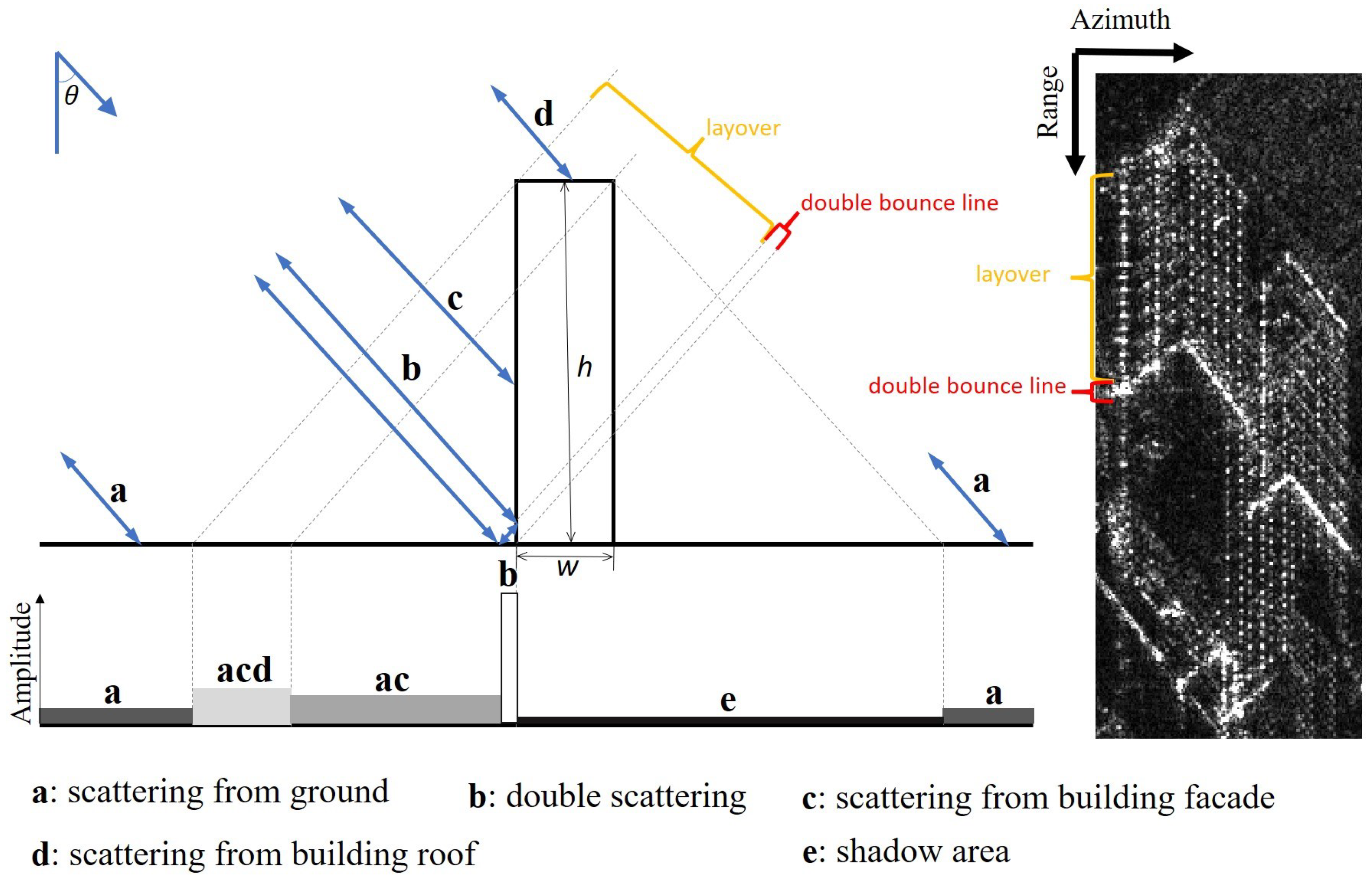

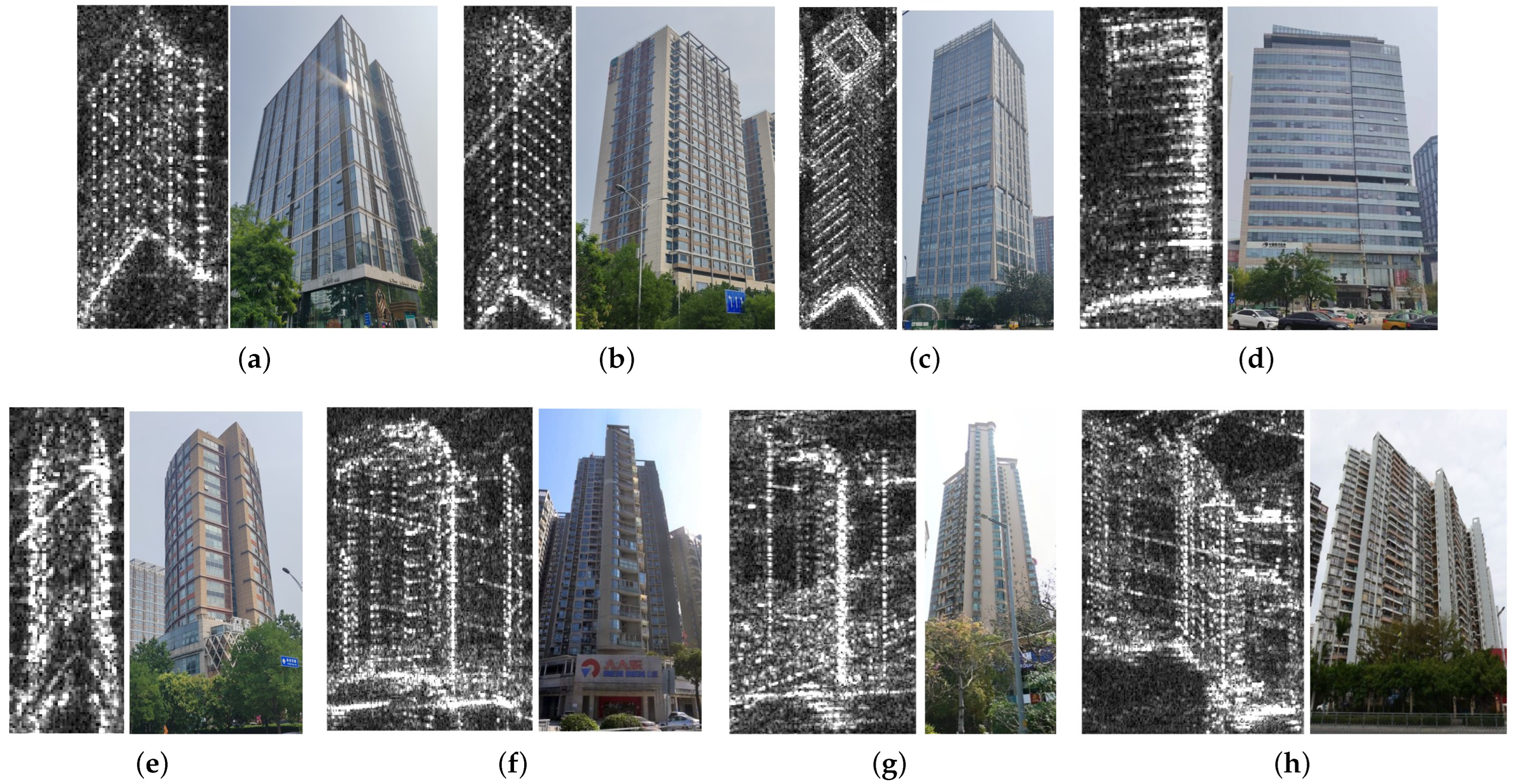





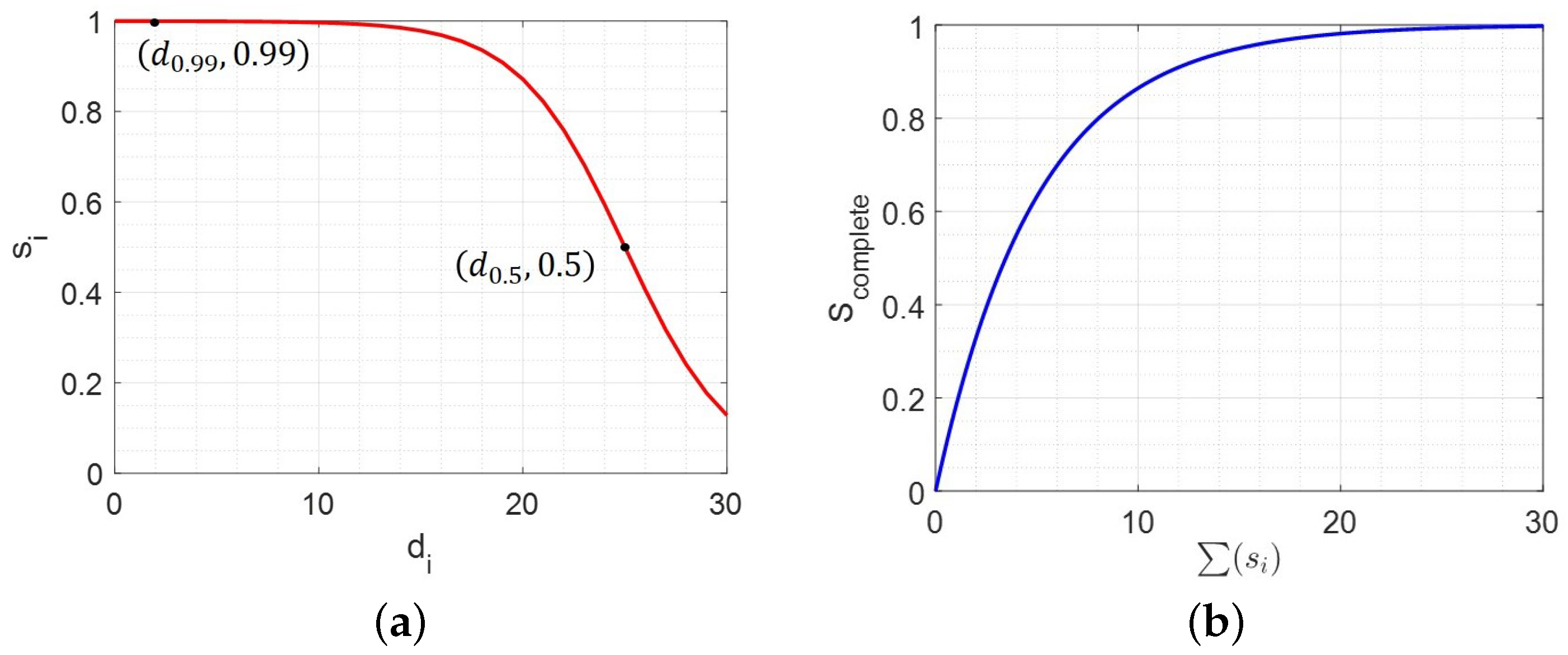
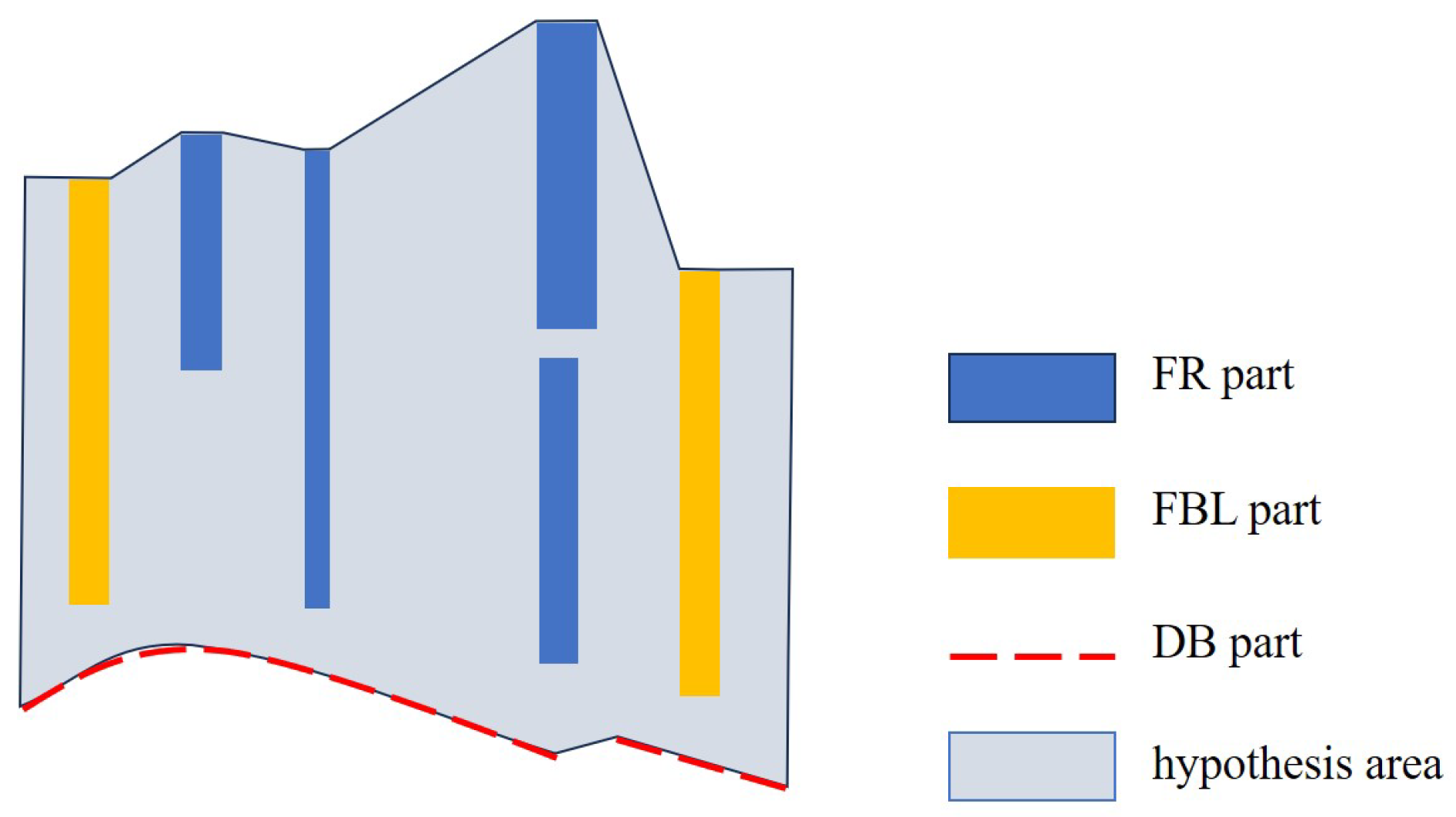
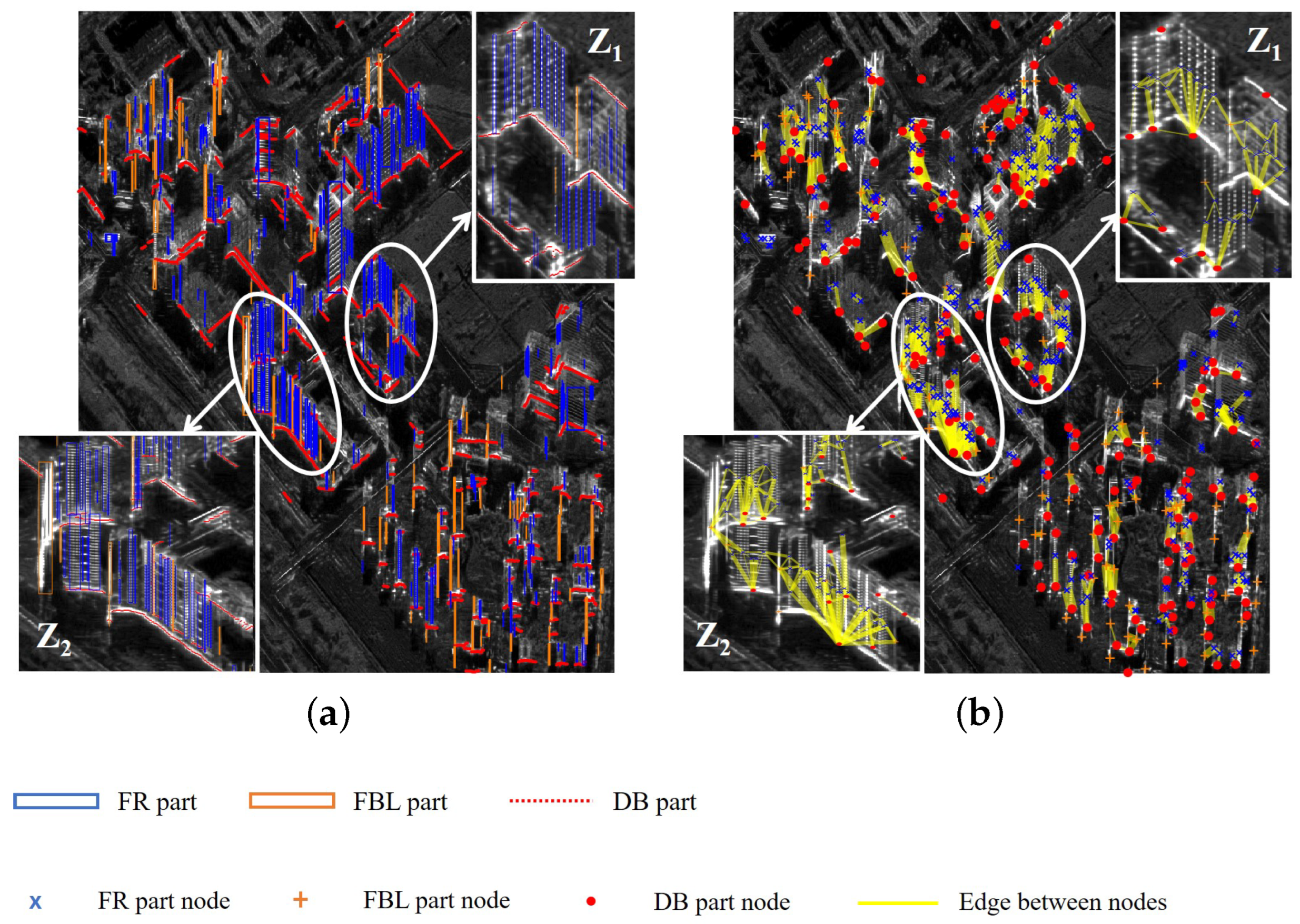
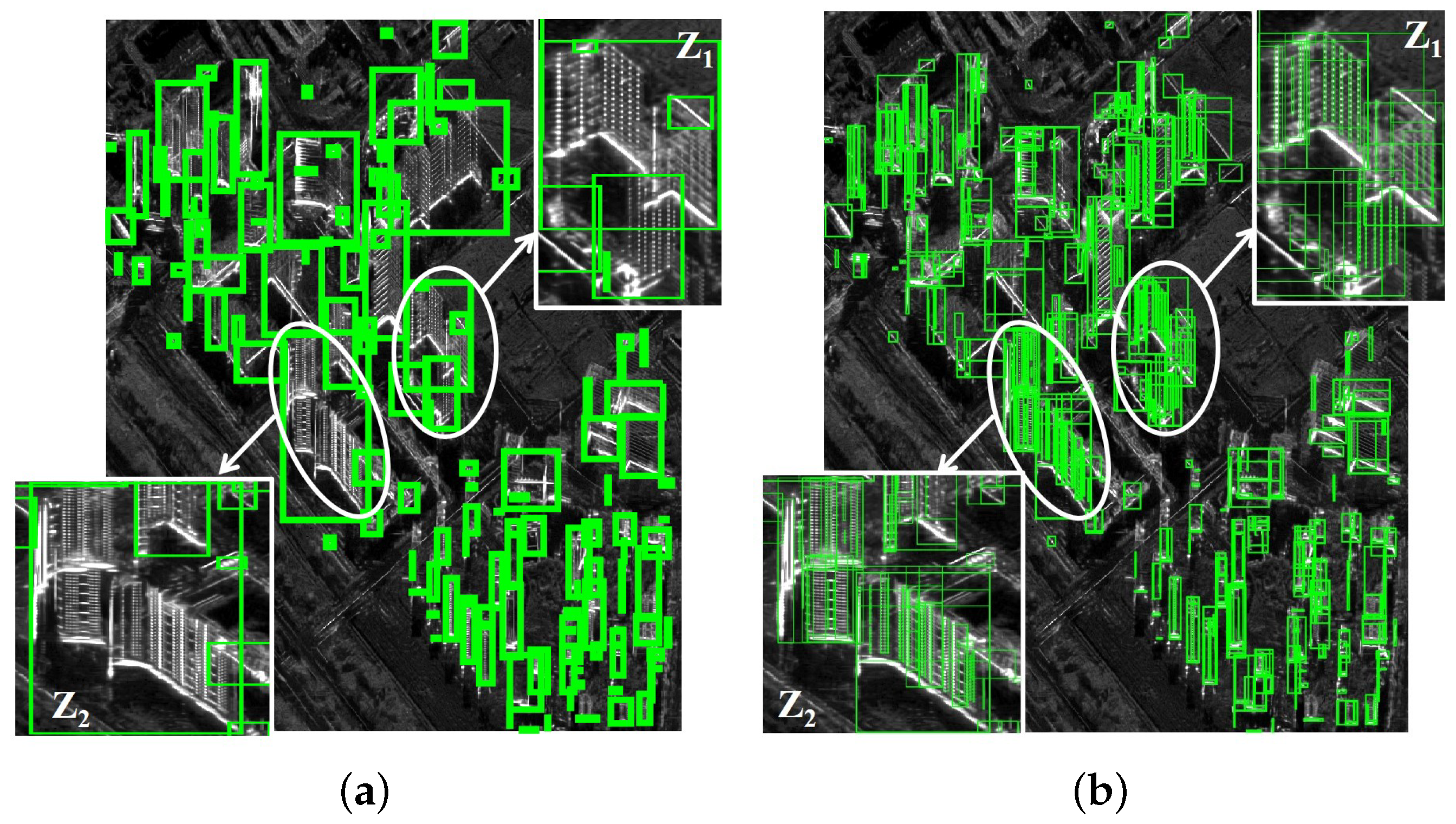
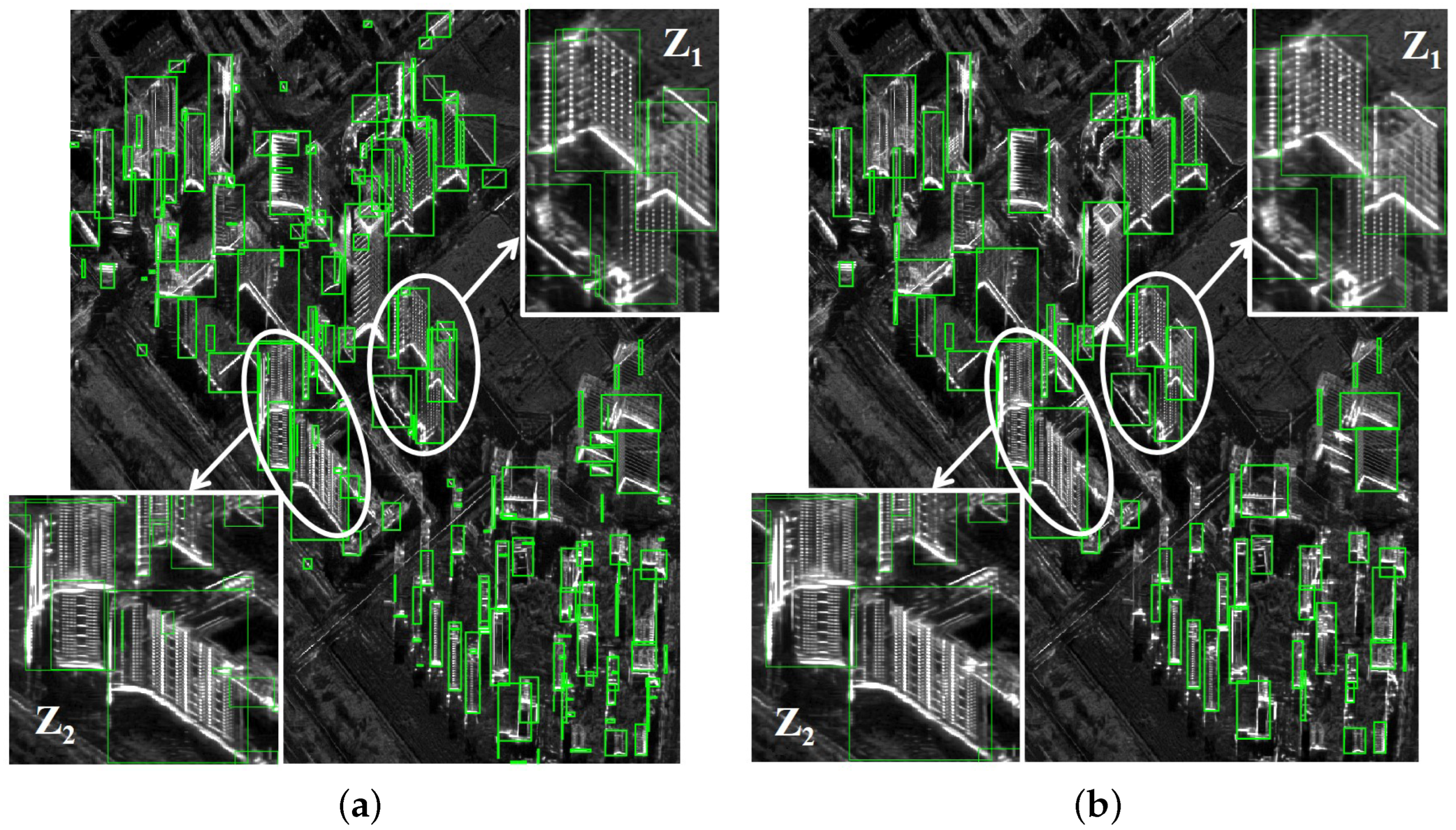

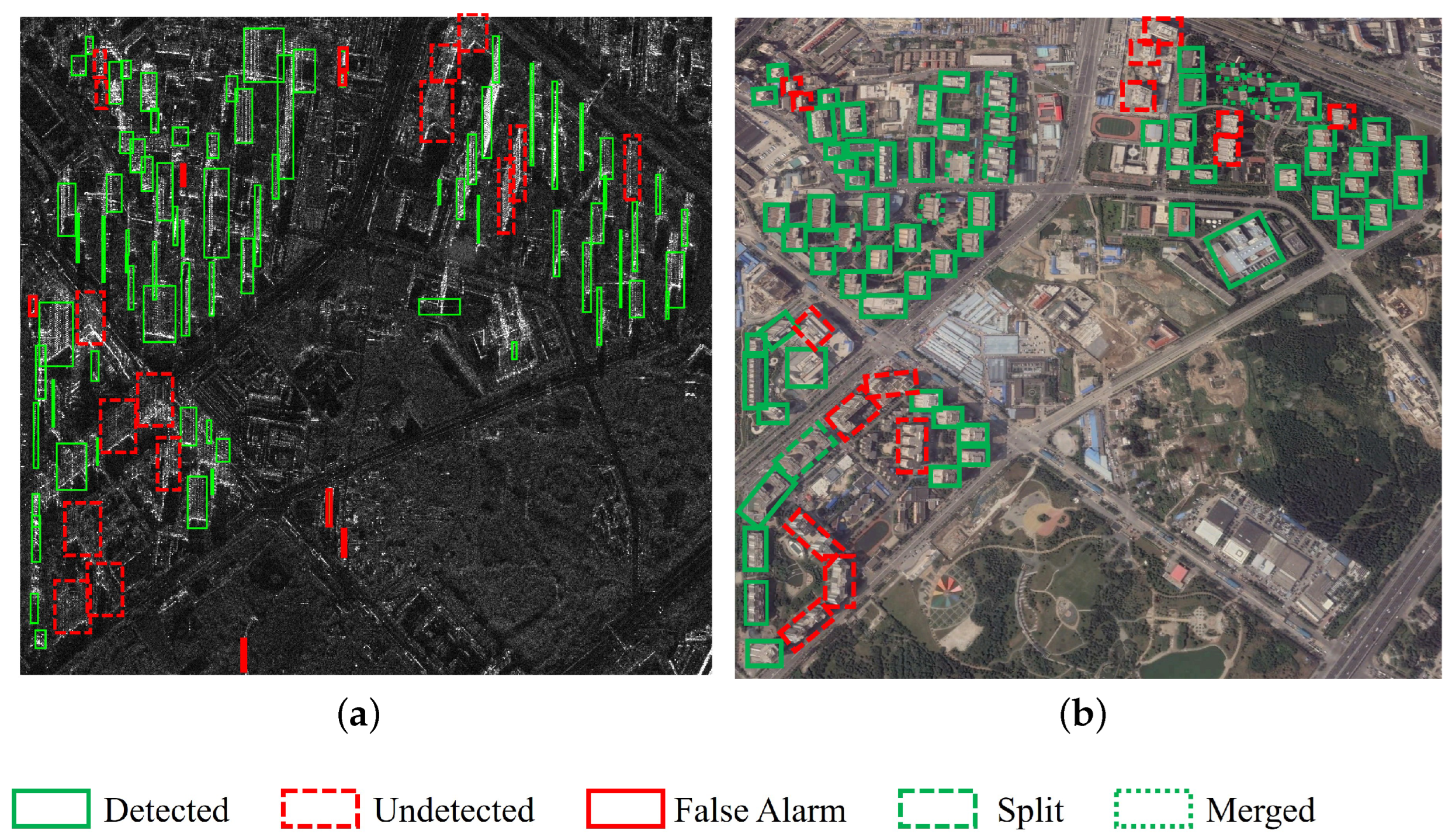
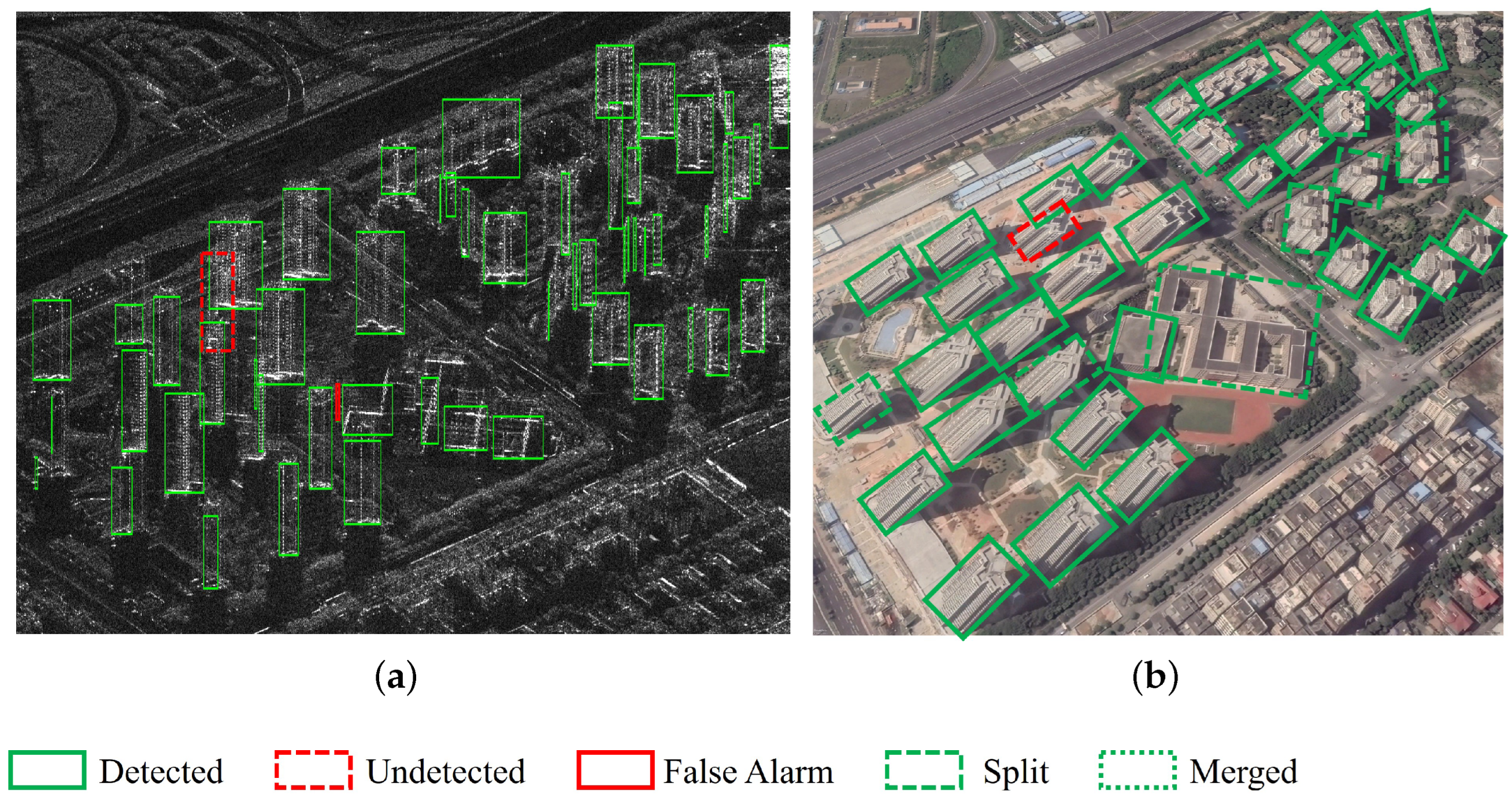
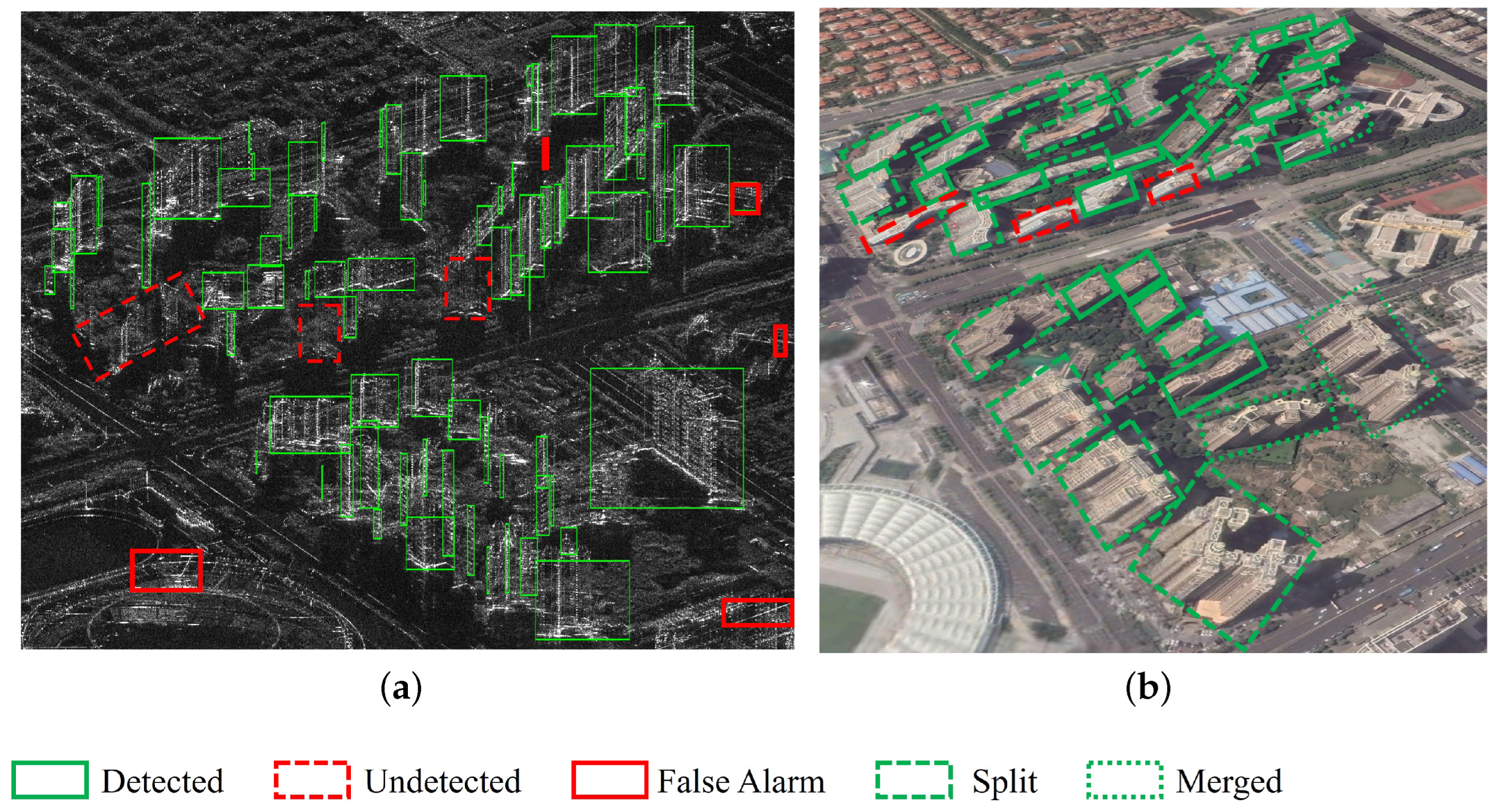

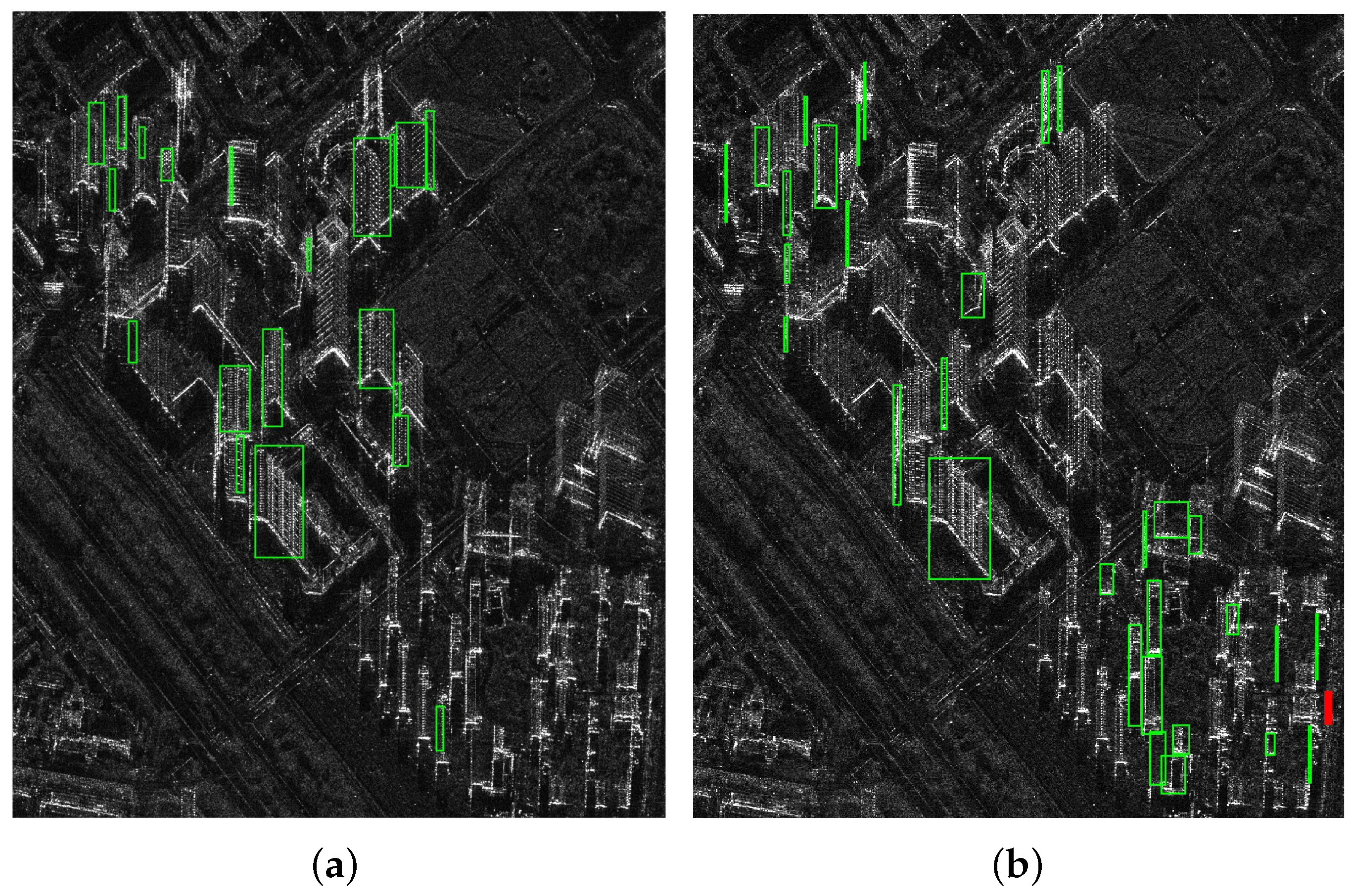
| Scene Number | Scene Location | Image Mode | Acquisition Date | Resolution * | Dataset Number | Image Size (Pixels) | Building Types Number | Spatial Density |
|---|---|---|---|---|---|---|---|---|
| 1 | Beijing | HS | 20130725 | 0.58 m × 1.1 m | 1 | 1660×1295 | many | dense |
| 2 | 1790×1880 | many | dense | |||||
| 2 | Shenzhen | ST | 20160813 | 0.58 m × 0.23 m | 3 | 950×3100 | several | dense |
| 4 | 1340×3340 | some | crowd | |||||
| 5 | 1010×2746 | several | crowd |
| Dataset Number | Number of Buildings | Extraction | False Alarms | Split | Merged | Precision (%) | Recall (%) | F1-Score |
|---|---|---|---|---|---|---|---|---|
| 1 | 60 | 56 | 5 | 10 | 12 | 91.80 | 93.33 | 0.93 |
| 2 | 88 | 73 | 7 | 5 | 6 | 91.25 | 82.95 | 0.87 |
| 3 | 40 | 39 | 1 | 10 | 0 | 97.50 | 97.50 | 0.98 |
| 4 | 42 | 39 | 5 | 18 | 4 | 88.64 | 92.86 | 0.91 |
| 5 | 30 | 29 | 5 | 21 | 2 | 85.29 | 96.67 | 0.91 |
| Sum * | 260 | 236 | 23 | 64 | 24 | 91.12 | 90.77 | 0.91 |
| Extraction Method | Number of Buildings | Extraction | False Alarms | Split | Merged | Precision (%) | Recall (%) | F1-Score |
|---|---|---|---|---|---|---|---|---|
| HRBE-Reg | 60 | 17 | 0 | 4 | 0 | 100 | 28.33 | 0.44 |
| HRBE-CL | 60 | 25 | 1 | 5 | 0 | 96.15 | 41.67 | 0.58 |
| HRBE-PM | 60 | 56 | 5 | 10 | 12 | 91.80 | 93.33 | 0.93 |
Disclaimer/Publisher’s Note: The statements, opinions and data contained in all publications are solely those of the individual author(s) and contributor(s) and not of MDPI and/or the editor(s). MDPI and/or the editor(s) disclaim responsibility for any injury to people or property resulting from any ideas, methods, instructions or products referred to in the content. |
© 2024 by the authors. Licensee MDPI, Basel, Switzerland. This article is an open access article distributed under the terms and conditions of the Creative Commons Attribution (CC BY) license (https://creativecommons.org/licenses/by/4.0/).
Share and Cite
Liu, N.; Li, X.; Hong, W.; Li, F.; Wu, W. Individual High-Rise Building Extraction from Single High-Resolution SAR Image Based on Part Model. Remote Sens. 2024, 16, 1278. https://doi.org/10.3390/rs16071278
Liu N, Li X, Hong W, Li F, Wu W. Individual High-Rise Building Extraction from Single High-Resolution SAR Image Based on Part Model. Remote Sensing. 2024; 16(7):1278. https://doi.org/10.3390/rs16071278
Chicago/Turabian StyleLiu, Ning, Xinwu Li, Wen Hong, Fangfang Li, and Wenjin Wu. 2024. "Individual High-Rise Building Extraction from Single High-Resolution SAR Image Based on Part Model" Remote Sensing 16, no. 7: 1278. https://doi.org/10.3390/rs16071278
APA StyleLiu, N., Li, X., Hong, W., Li, F., & Wu, W. (2024). Individual High-Rise Building Extraction from Single High-Resolution SAR Image Based on Part Model. Remote Sensing, 16(7), 1278. https://doi.org/10.3390/rs16071278





